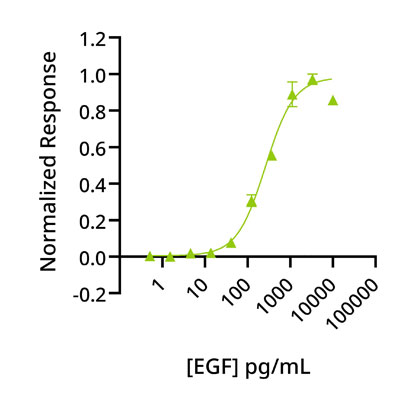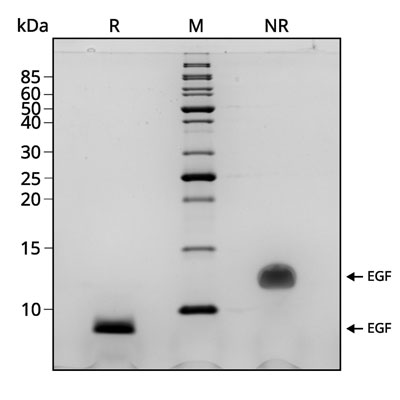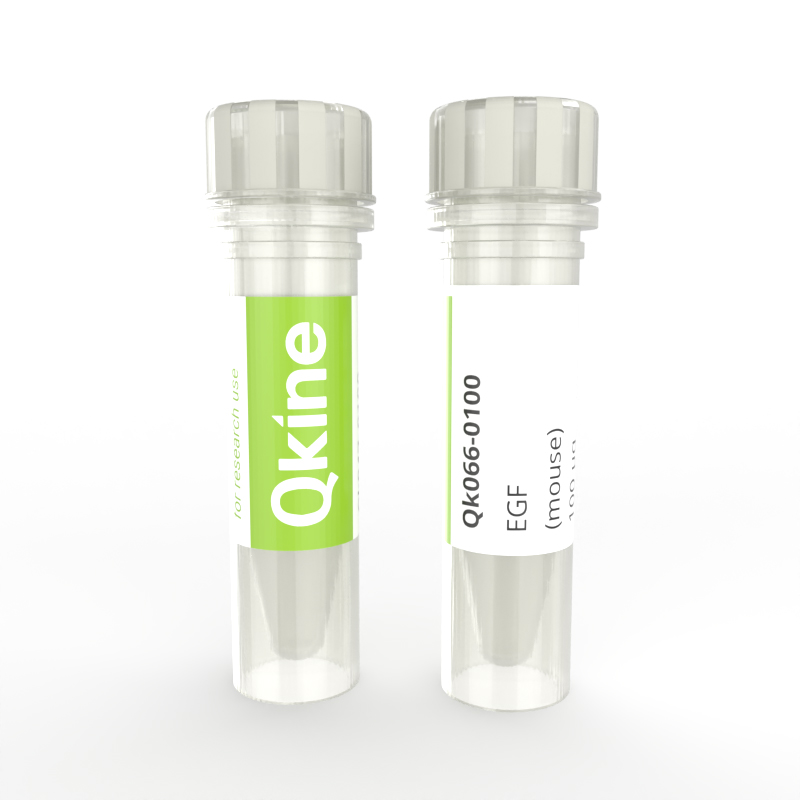Currency
Recombinant mouse EGF protein (Qk066)
Epidermal growth factor (EGF), a member of the EGF family of proteins, plays a significant role in regulating cellular processes such as cell growth, proliferation, differentiation, development, and tissue homeostasis. It is an essential growth factor in many stem cells and organoid culture media.
In cell culture, mouse EGF is crucial for stem cell maintenance, proliferation, differentiation, organoid culture growth and survival. It is also widely used for disease modelling, drug screening, tissue engineering, and regenerative medicine. Overall, EGF is a key player in cellular regulation and functions.
Mouse EGF is a high purity protein with a molecular weight of 6.1 kDa, animal origin-free, carrier-free and tag-free to ensure its purity with exceptional lot-to-lot consistency. Qkine mouse EGF is suitable for the culture of reproducible and high-quality stem cells and various tissue-specific organoids.
Orders are typically shipped same or next day (except Friday).
Easy world-wide ordering, direct or through our distributors.
1000µg will be despatched as 2 x 500µg
Fast and free shipping.
Buy online with secure credit card or purchase order.
For any questions, please email orders@qkine.com
Summary
High purity mouse protein (Uniprot number: P01132)
>98%, by SDS-PAGE quantitative densitometry
Source: Expressed in E. coli
6.1 kDa (Monomer)
Animal origin-free (AOF) and carrier protein-free
Manufactured in Cambridge, UK
Lyophilized from Acetonitrile/TFA
Resuspend in 10mM HCl at >100 µg/mL, prepare single-use aliquots, add carrier protein if desired, and store frozen at -20°C or -80°C.
Featured applications
Induced pluripotent stem cell culture and maintenance
Embryonic stem cell culture and maintenance
Organoid growth and proliferation
Cellular proliferation, migration and survival
Neuronal differentiation
Wound healing and tissue repair
Epidermal growth factor
EGF
mEGF
Mouse epidermal growth factor
Urogastrone
URG
HOMG4
beta-urogastrone
pro-epidermal growth factor
Epidermal growth factor (beta-urogastrone)
Mouse (100%)
Frequently used together
Bovine/porcine FGF-2 154 aa protein (Qk056)
Bovine/porcine FGF-2 154 aa protein (Qk040)
Human/bovine/porcine NRG-1 protein (Qk045)
Human/bovine/porcine IGF-1 protein (Qk047)
Human/bovine/porcine IGF-1 LR3 protein (Qk041)
Human/bovine/porcine TGF-beta 1 PLUS protein (Qk010)
Human/rat/bovine/porcine FGF-10 protein (Qk003)
Human/bovine/porcine Gremlin 1 protein (Qk015)
Human/mouse/rat/bovine BMP-2 protein (Qk007)
Human/mouse/rat/bovine/porcine Activin A (Qk001)
Human HGF (NK1) protein (Qk013)
Bioactivity

Recombinant mouse EGF (mEGF) activity is determined using the Promega serum response element luciferase reporter assay (*) in transfected HEK293T cells. Cells are treated in triplicate with a serial dilution of mEGF for 3 hours. Firefly luciferase activity is measured and normalized to the control Renilla luciferase activity. EC50 = 263 pg/mL (42 pM). Data from Qk066 lot #204608. *Promega pGL4.33[luc2P/SRE/Hygro] #E1340
Purity

Recombinant mouse EGF migrates as a major band at approximately 6 kDa in reduced (R) and at approximately 12 kDa in non-reduced (NR) conditions. No contaminating protein bands are present. The purified recombinant protein (3 µg) was resolved using 18% w/v SDS-PAGE in reduced (+β-mercaptoethanol, R) and non-reduced (NR) conditions and stained with Coomassie Brilliant Blue R250. Data from Qk066 lot #204608.
Further quality assays
Mass spectrometry, single species with the expected mass
Endotoxin: <0.005 EU/μg protein (below the level of detection)
Recovery from stock vial: >95%
We are a company founded and run by scientists to provide a service and support innovation in stem cell biology and regenerative medicine. All our products are exceptionally high purity, with complete characterisation and bioactivity analysis on every lot.
Protein background
Epidermal growth factor (EGF), a member of the EGF family of proteins including transforming growth factor alpha (TGF-α), amphiregulin, and betacellulin, plays a significant role in regulating cellular processes such as cell growth, proliferation, differentiation, development, and tissue homeostasis [1-3].
Mouse EGF, sharing substantial homology with its human counterpart, serves as a vital tool in studying cellular mechanisms, tissue regeneration, and disease pathology due to its close resemblance to human EGF. Widely utilized in cell culture, mouse EGF stimulates cell growth and sustains viability, particularly in stem cell applications, where it maintains pluripotency and facilitates the expansion of embryonic and induced pluripotent stem cells [4]. Additionally, mouse EGF directs stem cell differentiation towards specific lineages such as neural, epithelial or mesenchymal cells, crucial for applications in regenerative medicine, disease modelling and drug discovery [5-6]. In organoid cultures, mouse EGF is a key component of organoid culture media, supporting the development and maintenance of organoid structures derived from various tissues, including intestine, liver, brain and pancreas, by regulating stem cell self-renewal and differentiation, enabling the long-term expansion and differentiation of organoid cultures [7-8].
Aberrant expression of EGF has been implicated in diseases like cancer and skin disorders, offering therapeutic targets [1]. EGF-based therapies, including recombinant EGF proteins or EGFR-targeting drugs, are being explored for their potential in treating diseases [9-10]. Mouse EGF is also employed in tissue engineering strategies aimed at generating functional tissues and organs for transplantation. By incorporating EGF into scaffolds or growth factor cocktails, researchers can promote the growth, differentiation, and maturation of stem cells into tissue-specific cell types, facilitating the development of engineered tissues for regenerative medicine applications [6,11].
Structurally, mouse EGF shares a high sequence homology with human EGF, maintaining overall structural and functional conservation, although minor differences may exist in specific amino acid residues or post-translational modifications [12]. Mouse EGF contains EGF-like domains akin to human EGF, each typically composed of 40-50 amino acids with six conserved cysteine residues forming three intramolecular disulfide bonds, crucial for domain stability [13]. The arrangement of disulfide bonds in mouse EGF is similar to human EGF, essential for maintaining tertiary structure and biological activity [14]. Additionally, some EGF-like domains in mouse EGF may feature a calcium-binding site, facilitating stability and function. Mouse EGF’s receptor-binding region interacts with the extracellular domain of the EGF receptor (EGFR), initiating signaling cascades upon ligand-receptor binding [1]. This structural flexibility enables efficient recognition and binding to EGFR, facilitating downstream signaling pathways involved in cell growth, proliferation, and differentiation [1]. Overall, understanding these structural features is fundamental for elucidating mouse EGF’s functional mechanisms in regulating various cellular processes, including development, tissue homeostasis, and disease modeling.
In summary, mouse EGF plays a crucial role in stem cell maintenance, directed differentiation, organoid culture, disease modeling, drug screening, tissue engineering, and regenerative medicine. Its versatility and importance in these applications underscore its significance as a key factor in advancing research and therapeutic interventions aimed at understanding and treating various diseases and disorders.
FAQ
Mouse EGF (Epidermal Growth Factor) is a protein that belongs to the EGF family of proteins.
Mouse EGF is found in various tissues, including the gastrointestinal tissues.
Yes, mouse EGF is considered a cytokine that regulates various signalling pathways
The mouse EGF gene encodes the protein responsible for promoting cell proliferation, differentiation, and survival.
Mouse EGF binds to the EGF receptor (EGFR) or ErbB1, a receptor tyrosine kinase.
The mouse EGF receptor, when activated by binding with EGF, triggers intracellular signalling pathways involved in cell growth, proliferation, and differentiation.
The mouse EGF pathway refers to the signalling cascade initiated upon binding of EGF to its receptor (EGFR), leading to activation of downstream signalling pathways such as the MAPK/ERK pathway and the PI3K/Akt pathway.
Mouse EGF is commonly used as a supplement in cell culture media to promote cell proliferation and survival, especially in cultures of stem cells, epithelial cells and organoids. It helps in maintaining cell viability and stimulating cell growth in vitro.
Our products are for research use only and not for diagnostic or therapeutic use. Products are not for resale.



What others are saying
There are no contributions yet.